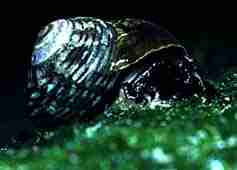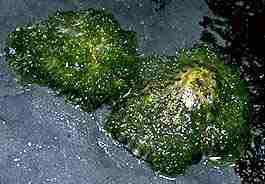|
|
Browsers & Grazers
 A
major source of food on shores is algae.
Some molluscs graze on the fronds
of the larger green, brown and red algae. One of these is the Common
Warrener, Turbo undulata. It grazes on algae at low
shore levels.
A
major source of food on shores is algae.
Some molluscs graze on the fronds
of the larger green, brown and red algae. One of these is the Common
Warrener, Turbo undulata. It grazes on algae at low
shore levels.

Here are some Common Variegated Limpets, Cellana tramoserica, with a covering of algae on their shells, but no algae on the rock surface. Why is this so ?
It is estimated that for every square centimetre of limpet, about 75 square centimetres of encrusting algae is necessary to maintain its life during its first year of growth.
On many rock surfaces you can see the small round home scars of these limpets, and if you look carefully you can pick out the area which is grazed by them. If you remove the limpets from an area, you will notice that in a short time tiny algae clumps begin to sprout and grow. In areas where the limpets remain, the rock remains bare.
As these molluscs move across the rock they rasp their tongue, called a radula, across its surface. The radula is a file-like ribbon of small horny teeth that all gastropods and some other molluscs possess. It can rasp either vegetable matter, or flesh in some carnivorous species, and convey the particles of food into the mouth.
However, most browsers and grazers do not fed on large macroalgae fronds. They feed on microalgae, algae spores and small plants trying to gain a foothold on the rock surface in moist depressions and pools.
High Shore Browsers and Grazers
Some browsers at the Splash Fringe Level and High Tide Levels are:
![]() Tubercled
Noddiwink, Nodilittorina pyramidalis,
Tubercled
Noddiwink, Nodilittorina pyramidalis,
feeds on lichens at high shore levels
![]() Blue
Australwink, Nodilittorina unifasciata,
Blue
Australwink, Nodilittorina unifasciata,
feeds on lichens at high shore levels.
![]() Petterd's
Limpet, Notoacmea petterdi
Petterd's
Limpet, Notoacmea petterdi
Mid Shore Browsers and Grazers
Some grazers and browsers of the mid-tide levels are:
![]() Zebra
Top Shell, Austrocochlea porcata,
Zebra
Top Shell, Austrocochlea porcata,
![]() Ribbed
Top Shell, Austrocochlea constricta
Ribbed
Top Shell, Austrocochlea constricta
![]() Wavy
Top Shell, Austrocochlea concamerata
Wavy
Top Shell, Austrocochlea concamerata
![]() Black
Nerite, Nerita atramentosa
Black
Nerite, Nerita atramentosa
![]() Striped-mouth
Conniwink, Bembicium nanum,
Striped-mouth
Conniwink, Bembicium nanum,
![]() Variegated
Limpet, Cellana tramoserica
Variegated
Limpet, Cellana tramoserica
Low Shore Browsers and Grazers
Other grazers at the low-tide level and Low Fringe level are:
![]() Black
Keyhole Limpet, Amblychilepas nigrita
Black
Keyhole Limpet, Amblychilepas nigrita
![]() Elephant
Snail, Scutus antipodes.
Elephant
Snail, Scutus antipodes.
![]() Common
Warrener, Turbo undulata
Common
Warrener, Turbo undulata
References:
Bennett, I. (1987) W. J. Dakin's classic study: Australian Seashores. p,242, Angus & Robertson, Sydney.
Davey, K. (1998) A Photographic Guide to Seashore Life of Australia. p.88, New Holland, Sydney.
Shepherd, S. A. & Thomas, I. M. (1982) Marine Invertebrates of Victoria, Pt. 2. p. 553, South Australian Government Printer, Adelaide.
Underwood, A. J. & Chapman, M. G. (1993) Seashores: a beachcomber's guide. p.30, New South Wales University Press, Sydney.
Nutrient
Absorbers
Grazers & Browsers
Suspension Feeders
Deposit Feeders
Carnivores
Omnivores
Trophic Levels
Energy Pyramid
Home
Page
Taxonomy
Biogeography
Rocky Shores
Tidal Levels
Intertidal Zonation
Environmental Factors
Biological
Factors
Feeding Relationships
Activities
Glossary
References
 Life
on Australian Seashores
Life
on Australian Seashores
by Keith Davey (C) 2000
Learning Consultant
- Media
The University of Newcastle
email at australian_seashores@hotmail.com
Scientific Consultant: Phil
Colman
site created 01.01.98 : updated 01.04.2000
